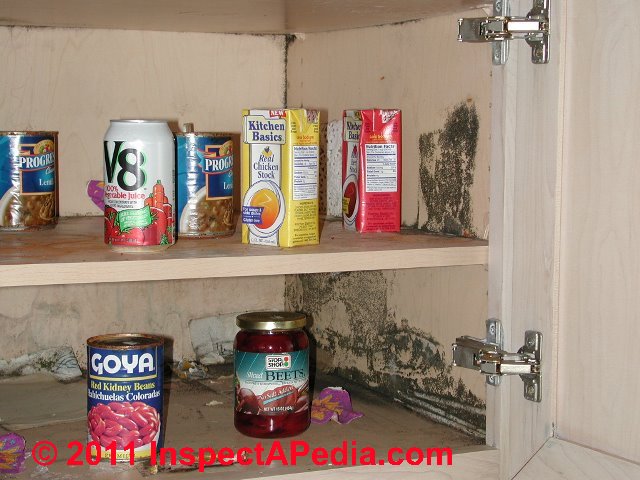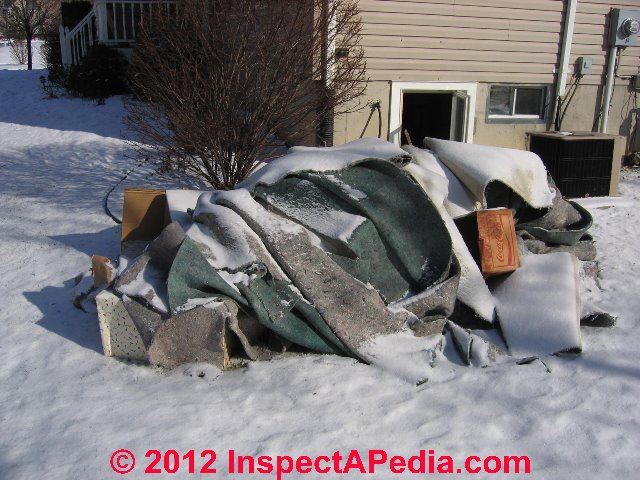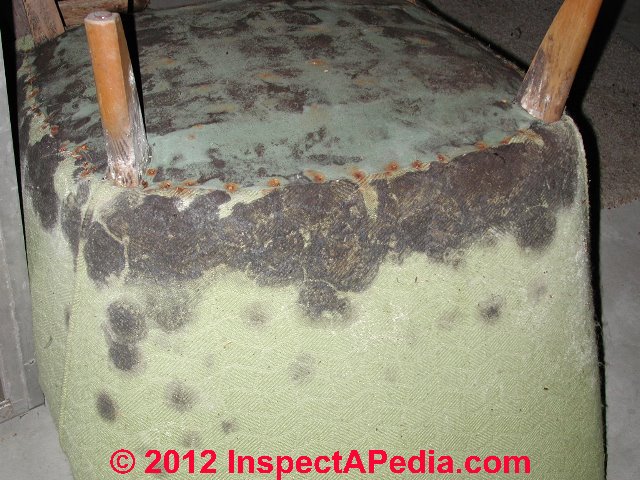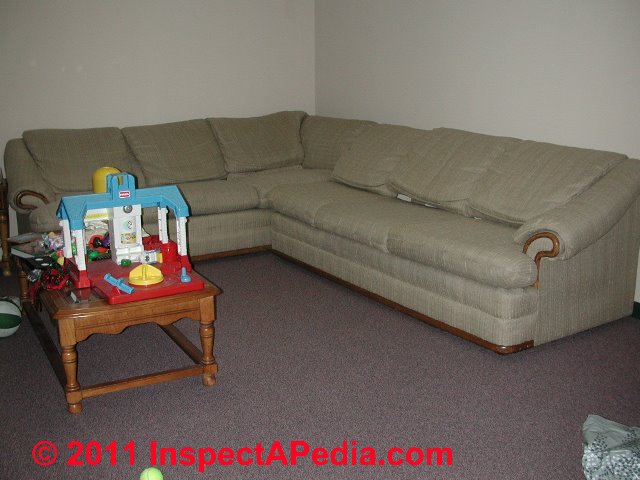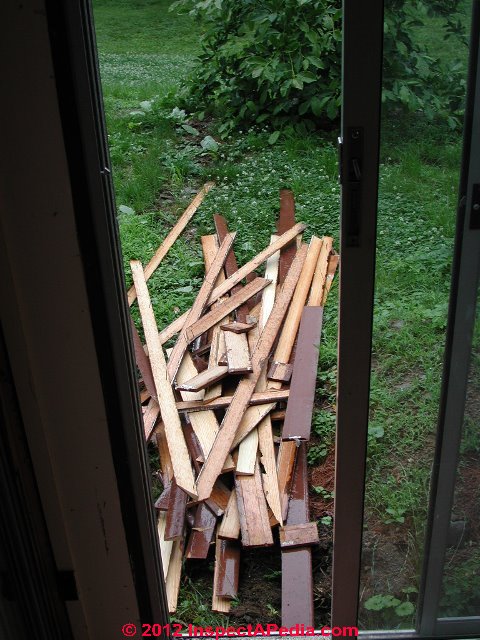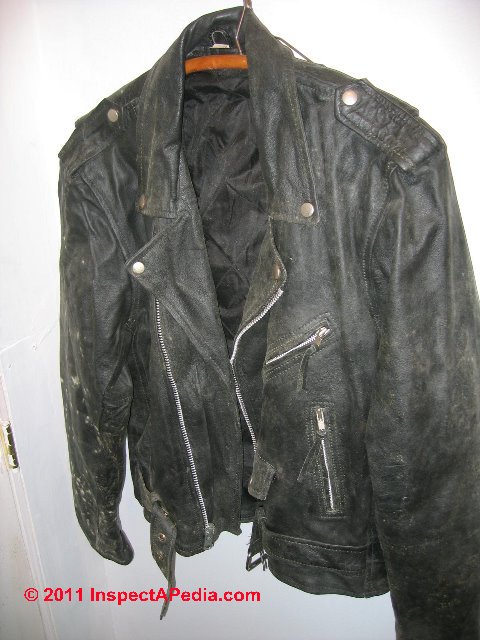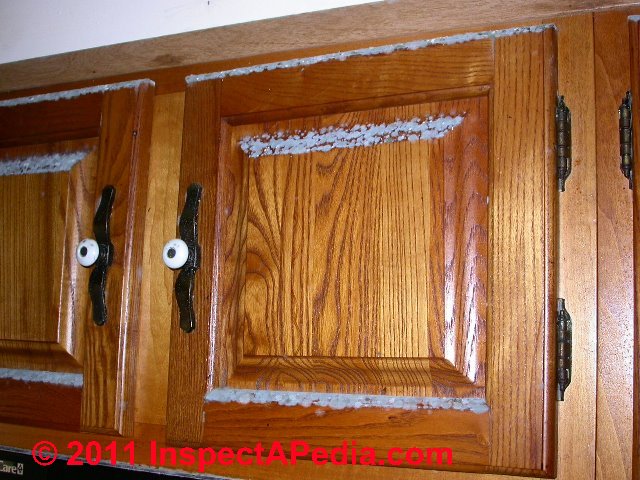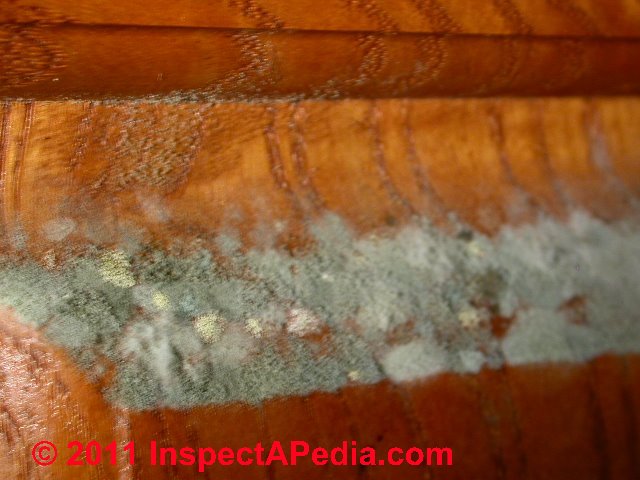 Salvage Building Contents
Salvage Building Contents
How to sort & salvage moldy or wet building contents
- POST a QUESTION or COMMENT about how to sort & salvage building contents after a flood
How to clean & salvage wet or moldy building contents:
This article describes procedures for salvaging building contents that have been wet by flooding, leaks or storm damage, and procedures for cleaning and salvaging moldy building contents such as bedding, carpets, clothing, drapes, dishes, furniture, mattresses, shoes, books or any other items in the home. We describe how to sort out the salvageable items from items that should be thrown away.
Certain valuable moldy items such as rare books may be worth the cost of special cleaning but if you can't immediately pay for that process it may be possible to dry and store the items safely until you can.
InspectAPedia tolerates no conflicts of interest. We have no relationship with advertisers, products, or services discussed at this website.
- Daniel Friedman, Publisher/Editor/Author - See WHO ARE WE?
How to Sort & Salvage Mold-Contaminated or Wet Building Contents
Mouldy Building Contents Salvage Advice in Four Steps
[Click to enlarge any image]
- First step - Safety: if your building is moldy or flooded be sure it is safe to enter.
See FLOOD DAMAGE REPAIR PRIORITIES where we also discuss safe entry into a potentially unsafe building.
For more detail also you may also want to
see BUILDING ENTRY for DAMAGE ASSESSMENT - Second step - Protect the building: if you have not begun steps to protect the building
see Step 2. GIVE YOUR HOME FIRST AID - Third step - Start building dryout: if your building has been flooded and you've not begun to dry it out
see BUILDING DRY-OUT PROCEDURES - Fourth step - Sort & salvage building contents: OK, so now we can address how to sort and salvage the contents of a home that have been exposed to mold, flooding, a sewage backup or other contaminants.
One reason for taking this step fairly early is to get salvageable goods out of the way of further demolition and cleaning that may be necessary in the building.
See SEWAGE BACKUP, WHAT TO DO
How to Sort Out Building Contents and Discard Debris Following a Flood, Fire or other Disaster
You have three types of contents that should go to three different places:
- Salvage: Items you do want to save will require prompt and special handling described in
our ITEMS TO SALVAGE discussion below.
Generally you can salvage easy-to-clean nonabsorbent materials such as dishes & tables as well as items that are economical to clean such as bedding & clothing.
As you'll read below some items require more careful inspection & thought in deciding to salvage them or to toss them out. - Trash: Things you don't want to save - items to be discarded (but not garbage) such as ruined upholstered furniture, wall to wall carpet and padding (photo at left), and other non-salvageable items described in
our ITEMS TO TOSS OUT list below. - Garbage: food waste, spoiled food, similar products that may pose a health hazard if not disposed-of properly and promptly
Items Soaked by Floodwater Should I Throw them Out?
These items should always be thrown out after wetting or a flood
- Baby toys, other stuffed toys that were soaked by floodwaters or sewage contaminants
- Carpeting & carpet padding, wall-to-wall, tacked or glued;
Area rugs or area carpets may be salvageable if removed and dried and cleaned in 24-48 hours.
For details about dealing with wet, moldy, or sewage-contaminated carpeting or rugs
See CAR SMELL - Mold DEODORIZING - advice for vehicles that have been flooded or are mold-contaminated
See CARPET MOLD / ODOR TESTS for carpeting or rugs that have been wet and may be mold-contaminated
see Step 6. FLOOD DAMAGED BUILDING CLEAN-UP for carpeting and rugs that have been wet by area or building floodingSee SEWAGE CLEANUP PROCEDURES & STANDARDS for carpeting or area rugs that have been wet by plumbing drain leaks or sewage backups
- Cosmetics
- Food
- Medical supplies
- Stuffed animals
Watch out: Don’t take chances with frozen food if electricity went off unless food is still thoroughly frozen and contains ice crystals. As a rule, food will remain frozen for up to three days in a closed freezer without power.
Don’t refreeze thawed food. However, you can cook and then freeze raw meat that was partially thawed and then refreeze it.
Questions about the Safety of Your Food? Call the USDA Food Safety Hotline: 1-800-535-4555 Professional home economists will answer your questions from 10 a.m. to 4 p.m. eastern time, Monday through Friday. Professional home economists will answer your questions from 10 a.m. to 4 p.m. eastern time, Monday through Friday.
Then throw the stuff out, preferably in sealed plastic garbage bags.
Usually these items should be thrown out after wetting or a flood or wet by sewage backup
- Books & documents though it may be possible to clean and salvage valuable books, papers & documents -
see BOOK / DOCUMENT MOLD & WATER DAMAGE RESTORATION - Cabinets if badly water-damaged or if made of chip-board that has absorbed sewage. Cabinet removal, cleaning & salvage are discussed below
at CABINET SALVAGE - Foam rubber
- Food (see below)
- Mattresses
- Paper products.
- Pillows
- Upholstered couches and chairs
Black mold growth (actually dark brown mold) was not visible on this living room couch set until a closer inspection was made.
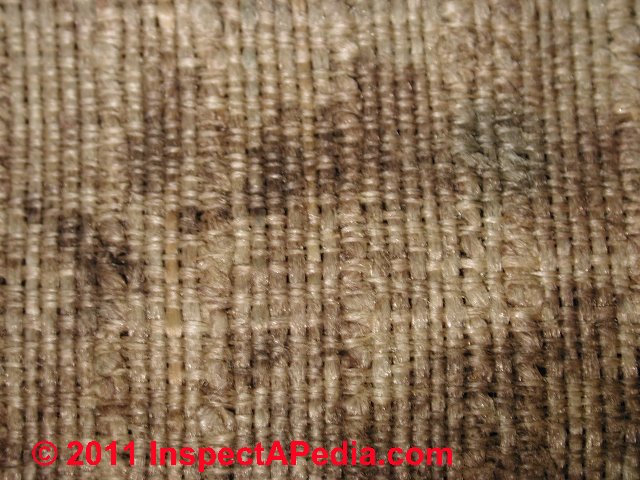
Must-Toss Items: Things you can't or don’t want to save after a building flood, fire, or other disaster
Put things you don’t want to save outside to dry until the adjuster comes to confirm your losses.
Take pictures or videotapes and list each item for the record.
If you are not sure whether to throw something out, decide whether it is worth salvaging by checking the information in Step 6.
Garbage Items & Garbage Disposal - health hazard warning
Get rid of food and anything else that could spoil or go bad immediately. Don’t let garbage build up.
Garbage piles will cause yet another health hazard by attracting animals and insects.
If your insurance adjuster has not come, tell your agent or adjuster that you need to get rid of potential health hazards. That person will tell you
How to Dispose of discarded items properly after a flood, hurricane, fire or other disaster

Do not burn or bury them. There will usually be more frequent garbage pickups after a flood. Your local TV and radio stations will have announcements concerning trash pickup schedules and drop-off sites.
Framing and structural components can be kept
Unlike wallboard, wet studs and sills that are touched by floodwaters do not need to be thrown out.
Interior Hollow-Door Doors, Trim & Similar Items are usually Thrown Out
Our photo of floor baseboard trim exploration (below left) shows what happens when trim is left in place at the bottom of a wet floor. Better would have been to remove the trim and the bottom 12-inches of drywall to dry and inspect the wall cavity.
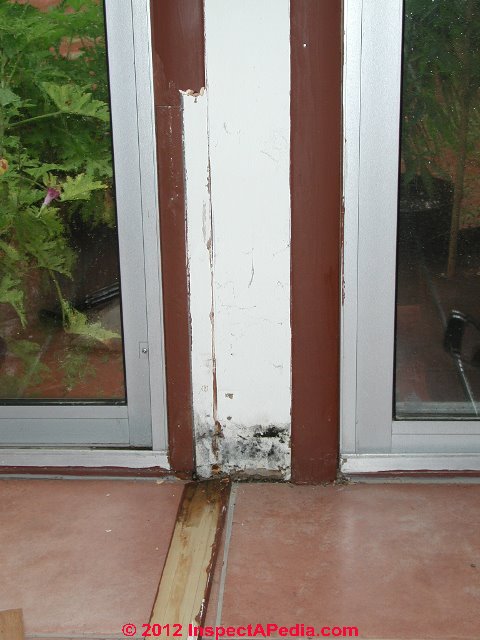
In the photos above and just below we show the right way to handle trim in a flooded building - remove it and pile it with site trash to be removed - as a first step in addressing wet walls and wall cavities (discussed below).
Watch out: in our experience [DF] when a building has been wet enough to allow water to enter even just the very bottom of a wall cavity, there is a high risk of harmful and costly mold contamination of both the interior wall cavity surfaces as well as wall insulation.
More advice on handling wall and floor cavities where the floors have been wet is
at Step 6. FLOOD DAMAGED BUILDING CLEAN-UP for carpeting and rugs that have been wet by area or building flooding
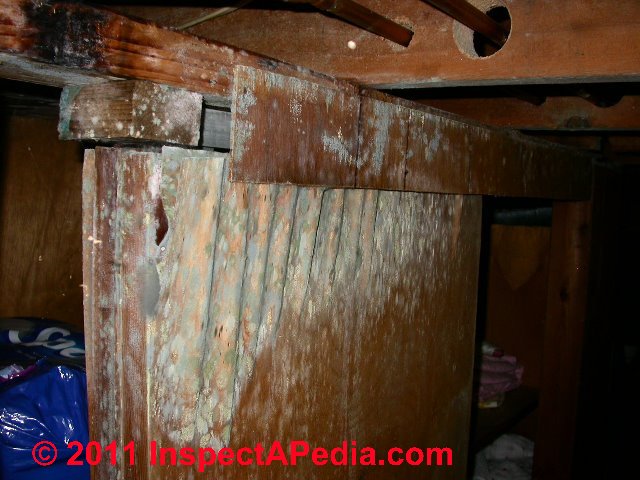
Hollow wood and plastic or vinyl doors usually have cardboard spacers in the middle that lose their shape when wet.
Generally, hollow-core doors come apart after they are flooded sand need to be replaced.
Things you do want to save in a Building that has Been Wet by Floods, Storms, Fires, etc.
Move & Store Items to be salvaged
For items that are dry, un-touched by floodwaters or sewage backjup, move these items to a safe, dry place or store them under-cover outdoors.
For items that are wet but are salvageable, move these items to a separate safe, dry place or store them under-cover outdoors briefly until they can be properly cleaned and dried. Typically you have 24-48 hours to clean and dry salvageable soft items and longer to salvage hard-surface items such as dishware or cookwarer.
The longer flooded-items sit in water or remain wet, the more damaged they become.
Watch out: ARC and FEMA advice for relocating salvaged items such as " In some cases, you may only be able to move them to a dry or clean room in the same building while you clean the other rooms." can be risky.
- Area rugs or area carpets may be salvageable if removed and dried and cleaned in 24-48 hours.
- Don't move wet but salvageable items into a building area where their water or moisture content will cause water, high moisture, or high mold risk in the new stored-in area.
- Don't move sewage-contaminated items into an occupied building area nor into a building area that has other than a sealed, easy-to-clean/disinfect floor.
- Don't move mold-contaminated items into an occupied building area nor into a building area where high levels of moldy dust and debris will cross-contaminate the stored-in building surfaces or contents.
Should You Move Salvage Items to Your New or Temporary Residence?
Watch out: Beware of bringing moldy contents out of a building into a new residence as you may import high-enough levels of mold to irritate building occupants even if the new location does not encourage mold growth.
Yet you can't simply leave possessions to be salvaged in a wet, mold-conducive or sewage-contaminated building.
Not only are these items in the way of building dry-out and clean-up operations, but the items themselves may become so badly damaged that the become beyond salvage.
Use Temporary Contents Storage: rental space, garage, other building areas for salvage items
What about moving flood-damaged items to a Self-Storage rental facility
Watch out: think thrice before moving wet or contaminated salvage items directly to a storage facility in their wet, soiled state.
You risk violating your rental contract, cross-contaminating the stored items of other tenants, and thanks to the out-of-sight / out-of-mind problem I've found that storing such items frequently leads to continued mold or sewage pathogen growth, worse contamination, sometimes to the point that the items are no longer salvageable. You've basically paid rent to store trash.
The black leather jacket you see at left was covered with extensive mold contamination but was salvageable by professional cleaning.
Watch out: leaving soft goods (that are costly or difficult to clean) in a mold-contaminated area means that those items are likely to need extra (and more expensive) cleaning before they can be returned to use.
Don’t leave wood furniture in the sun where it will warp as it dries.
To save an area rug, lay a sheet or some other material on top so the colors will not bleed. Clean it promptly.
Don't leave a wet but valuable area rug that is to be salvaged rolled-up.
You may find (as I did) that colors bleed so that the rug is damaged even if it can be later cleaned. Also the longer a wet rug or carpet is rolled-up or folded up the more extensive may be its mold contamination, making it harder to clean.
On-Site Cleaning & Storage of Salvaged Building Contents
Reasonable places to store salvage items that are to be cleaned are on a clean dry concrete floor of an attached or detached garage that is not itself already filled with items that would be cross-contaminated, or in a dry outdoor area that is protected from the weather.
Alternatively you may contract with a professional cleaning service to remove the items directly to a cleaning facility where they will be cleaned and sanitized as needed and then relocated again to a clean-dry storage area.
On a large project where a valuable inventory of stored material had become exposed to mold contamination, the U.S. Park Service arranged for the cleaning contractor set up cleaning stations right at the building.
Items were first rough-cleaned right in the wet moldy basement, then brought out of the area of contaminat5ion to a series of two cleaning stations where the items were cleaned, then followed by (my) testing station that used an on-site microbiology lab to test the cleaned materials.
Using this approach we were able to detect and correct a problem with the cleaning system (re-using moldy cloths to wipe subsequent items), thus assuring that the cleaned items were in fact adequately clean. From that station items were moved to an on-site storage trailer pending future relocation and use.
Wet or Moldy Building Contents Cleaning Procedures
Contents from the building can in some cases be salvaged by cleaning, but just what can be cleaned depends on the nature of the material and also its value compared to the cost of cleaning and salvage.
Hard-surfaced items are easily washed or cleaned. Here we refer to things like china, dishes, glassware, silverware, hard plastic items, most solid wood items (though un-coated wood surfaces may require special cleaning & sealing).
A mostly wood chair with an upholstered seat may be most-economically salvaged by removing and tossing the upholstered seat covering and padding.
Soft goods like clothing and bedding can be laundered or dry-cleaned.
Soft goods that have not been wet but may have been exposed to moldy dust may be salvageable by HEPA vacuuming and cleaning.
Soft goods like carpets and upholstered furniture, if visibly moldy or if they have been wet, are often beyond economical repair. Books and papers require special handling - see BOOK / DOCUMENT MOLD & WATER DAMAGE RESTORATION
See BUILDING DRY-OUT PROCEDURES for a discussion of sorting out building contents for salvage after flooding or wetting conditions.
Stay away from magic bullets that don't work like ozone treatments for moldy homes or bleach to "kill the mold" - that is the wrong approach. See
How to Salvage, Dry, Clean & Restore Kitchen & Bathroom Countertops & Cabinets After a Flood or other Disaster
To salvage cabinets and counter tops that have not been badly water-damaged but that were mounted in a room that was soaked by flooding, fire extinguishment, storm damage or similar events,
we [DF] find that you will need to remove wall mounted cabinets (on walls that were wet) and floor mounted cabinets (on floors that were soaked or flooded) to permit the cabinets to be properly dried and cleaned.

If there has been protracted leakage or spillage under built-in cabinets such as bath vanities, there may be a mold cleanup job under or behind these components. We removed this bath vanity after receiving complaints of recurrent moldy odor in this bathroom. No amount of cleaning of other bath surfaces had reduced the mold smell. A slight slope in the bathroom floor had been sending tub spillage behind this bath vanity for decades.
What makes a lot of sense sense is to study the building carefully to decide on the building points at most risk of having been wet from leaks due to construction details or other site observations. That's where one would make a test cut.
Our photos below illustrate the mistake of assuming that a plastic laminate countertop is necessarily "mold free".
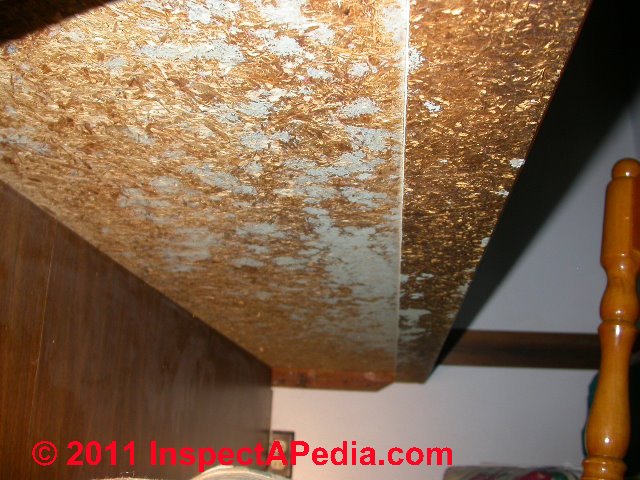
Our opinion was that the countertop above could be cleaned (below) and sealed with a fungicidal sealant; but further investigation was warranted to discover the presence of significant mold contamination behind or beneath wall and floor mounted cabinets. The decision to investigate such areas depends on the building's water entry history and just what has been wet.
Often we can explore the backs of interior-wall-mounted cabinets by one or a few strategic test cuts made through the opposite side of their mounting wall.
Watch out: often the short-cut of leaving wall or floor mounted cabinets in place on surfaces that have been wet means that the back or under-side of the cabinet develops severe mold contamination - such as the back-side of the cabinet shown in our photo at left.
Don't do it. In my experience the claims that water extractors can magically remove water from enclosed wall, floor or ceiling cavities often lead to expensive disappointment while cabinet removal along with a few strategic drying cuts would have done the trick.
Where cabinets were left in place, or for cabinets mounted on an exterior wall, removal of the cabinets and exploration of the wall and wall cavity behind them may make more sense.
For details about finding and handling mold and water damaged bathroom or kitchen cabinets and countertops see
...
Continue reading at Step 5. RESTORE UTILITIES AFTER FLOODING if your building has been flooded or choose one of the articles listed below.
Continue at MOLD ACTION GUIDE - WHAT TO DO ABOUT MOLD if you are responding to a mold contamination problem
Continue at SEWAGE BACKUP, WHAT TO DO if you are responding to a sewer backup
Or see these
Relaged Articles
- BOOK / DOCUMENT MOLD & WATER DAMAGE RESTORATION
- FLOOD DAMAGE CLEANUP & REPAIR GUIDE - home
- FLOOD DAMAGE REPAIR PRIORITIES
- FLOOD & DISASTER BUILDING DAMAGE REPAIR PROCEDURES
- Step 1. TAKE CARE OF YOURSELF FIRST
- Step 2. GIVE YOUR HOME FIRST AID
- Step 3. GET ORGANIZED
- Step 4. BUILDING DRY-OUT PROCEDURES
- SALVAGE BUILDING CONTENTS
- Step 5. RESTORE UTILITIES AFTER FLOODING
- MOLD CONTROL, FLOOD RESPONSE
- Step 6. FLOOD DAMAGED BUILDING CLEAN-UP
- Step 7. CHECK ON FINANCIAL ASSISTANCE
- Step 8. REBUILD AND FLOODPROOF
- Step 9. FLOOD & STORM INSURANCE
- FLOOD-CAUSED MOLD PREVENTION
- FLOOD REPAIR CONTRACTORS
- WHEN TO STOP LOOKING FOR MOLD
- FLOOD & STORM DAMAGE REFERENCES for damage assessment & cleanup
Suggested citation for this web page
SALVAGE BUILDING CONTENTS at InspectApedia.com - online encyclopedia of building & environmental inspection, testing, diagnosis, repair, & problem prevention advice.
Or see this
INDEX to RELATED ARTICLES: ARTICLE INDEX to BUILDING DAMAGE, DISASTER, REPAIRS
Or use the SEARCH BOX found below to Ask a Question or Search InspectApedia
Or see
INDEX to RELATED ARTICLES: ARTICLE INDEX to BUILDING STRUCTURES
Or use the SEARCH BOX found below to Ask a Question or Search InspectApedia
Ask a Question or Search InspectApedia
Try the search box just below, or if you prefer, post a question or comment in the Comments box below and we will respond promptly.
Search the InspectApedia website
Note: appearance of your Comment below may be delayed: if your comment contains an image, photograph, web link, or text that looks to the software as if it might be a web link, your posting will appear after it has been approved by a moderator. Apologies for the delay.
Only one image can be added per comment but you can post as many comments, and therefore images, as you like.
You will not receive a notification when a response to your question has been posted.
Please bookmark this page to make it easy for you to check back for our response.
IF above you see "Comment Form is loading comments..." then COMMENT BOX - countable.ca / bawkbox.com IS NOT WORKING.
In any case you are welcome to send an email directly to us at InspectApedia.com at editor@inspectApedia.com
We'll reply to you directly. Please help us help you by noting, in your email, the URL of the InspectApedia page where you wanted to comment.
Citations & References
In addition to any citations in the article above, a full list is available on request.
- [1] REPAIRING YOUR FLOODED HOME [PDF], American Red Cross & FEMA: Federal Emergency Management Agency, FEMA PO Box 2012, Jessup MD 20794-2012. Printed copies of this book are available from the American Red Cross, from your local Red Cross chapter, or by writing to the address above. Web search 10/4/2010, original source: http://www.redcross.org/www-files/Documents
/pdf/Preparedness/file_cont333_lang0_150.pdf - [2] The following are available free from:
- Federal Emergency
Management Agency
Attn: Publications
P. O. Box 2012
Jessup, MD 20794-2012
- Design Manual for Retrofitting Flood-prone Residential Structures, FEMA-114. This detailed manual explains all the floodproofing options in language a homeowner can understand.
- Elevated Residential Structures, FEMA-54.
- Floodproofing Non-residential Structures, FEMA-102.
- Coastal Construction Manual, FEMA-55.
- Manufactured Home Installation in Flood Hazard Areas, FEMA 85.
- [3] The following are available for
free from:
U.S. Army Corps of Engineers
Attn: CECW-PF
20 Massachusetts Avenue, NW
Washington, D.C. 20314
- Introduction to Flood Proofing, John R. Sheaffer, 1967
- Flood-Proofing Regulations, U.S. Army Corps of Engineers, Pittsburgh District, 1990, 80 pages (Corps publication EP 1165 3 314).
- Flood Proofing Systems & Techniques, L.N. Flanagan, editor, 1984
- Flood Proofing Tests, Tests of Materials and Systems for Flood Proofing Structures, Corps of Engineers, National Flood Proofing Committee, August, 1988.
- Raising and Moving the Slab- On-Grade House, Corps of Engineers National Flood Proofing Committee, 1990.
- [4] The following publications are
available from the American Red
Cross. Contact your Red Cross
chapter for more information:
- Your Family Disaster Plan (ARC 4466)
- Su plan para el hogar en caso de desastres (ARC 4466S)
- Your Family Disaster Supplies Kit (ARC 4463)
- Su Equipo de suministros para la familia en caso de desastres (ARC 4463S)
- Safe Living in Your Manufactured Home (ARC 4465)
- Are You Ready for a Flood or Flash Flood? (ARC 4458)
- ¿Está preparado para una inundación or inundación súbita? (ARC 4458S)
- Are You Ready for a Hurricane? (ARC 4454)
- ¿Está preparado para un huracán? (ARC 4454S)
- [5] Clean up References Many Cooperative Extension Service offices have home economists and food and farm experts. Check your telephone book under the county name. For example, if you live in Pittsburg County, check under “Pittsburg County Cooperative Extension Service”.
- [6] Questions on cleaning or disinfecting of specific materials can be answered by manufacturers of cleaning products. Check the product labels for toll free telephone numbers.
- [7] References on technical aspects of floodproofing can be located through the Floodplain Management Resource Center, a free service provided by the Association of State Floodplain Managers. Call 303/492-6818
- [8] CMHC, Canadian Mortgage and Housing Corporation, "After the Flood — A Homeowner’s Checklist", retrieved 10/21/2012, original source http://www.cmhc-schl.gc.ca/en/co/maho/em/em_001.cfm [copy on file as After_The_Flood_CMHC.pdf]
- [9] Como Reparar su Hogar Inundado, American Red Cross and FEMA - PDF - espanol
- [10] Flood Cleanup - Avoiding Indoor Air Quality Problems,> US EPA Fact Sheet
- [11] Cleaning Up After a Flood, Texas Department of State Health Services.
- In addition to citations & references found in this article, see the research citations given at the end of the related articles found at our suggested
CONTINUE READING or RECOMMENDED ARTICLES.
- Carson, Dunlop & Associates Ltd., 120 Carlton Street Suite 407, Toronto ON M5A 4K2. Tel: (416) 964-9415 1-800-268-7070 Email: info@carsondunlop.com. Alan Carson is a past president of ASHI, the American Society of Home Inspectors.
Thanks to Alan Carson and Bob Dunlop, for permission for InspectAPedia to use text excerpts from The HOME REFERENCE BOOK - the Encyclopedia of Homes and to use illustrations from The ILLUSTRATED HOME .
Carson Dunlop Associates provides extensive home inspection education and report writing material. In gratitude we provide links to tsome Carson Dunlop Associates products and services.




